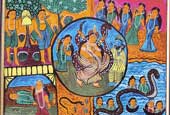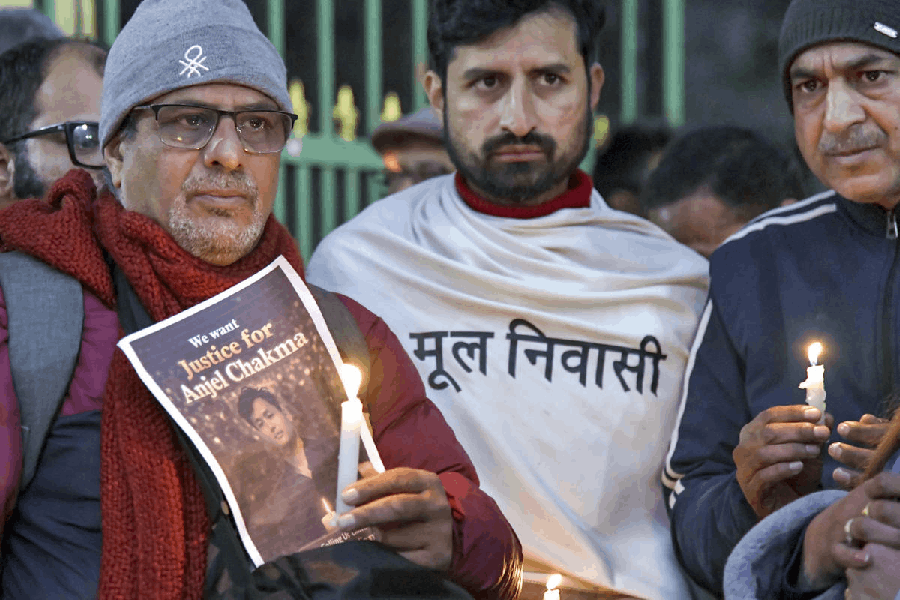 |
Behula-Lakhinder faces tough competition from Kate Winslet-Leonardo Di Caprio. The Hollywood star pair is almost nudging out the mythical folklore couple from its traditional mainstay of pata paintings, a dying art form of rural Bengal.
Improvising on her inherited knowledge of the art, Swarna Chitrakar of Pingla block, in West Midnapore, sketched Winslet and Di Caprio sitting pretty aboard the Titanic, going by what she had heard of the blockbuster from a neighbour. The saleability factor determines the survival of the craft, says Swarna, which is why she and others like her are trying to catch the drift of the times.
That the winds of change have swept through some remote pockets of Midnapore, having the largest concentration of patua families, is obvious at the five-day (February 18-22) display-cum-sale of pata paintings by 42 women artists at Madhusudan Mancha. T-shirts and saris have replaced the scroll (traditional paper for the paintings), while lasting and user-friendly acrylic colours are surging ahead of indigenous dyes.
Financed by DFID, the workshop is part of a 12-month project run by the School of Women’s Studies, Jadavpur University, partnered by the Folk and Tribal Cultural Centre, West Bengal, and London School of Economics. Since April last year, around 75 women patuas from the two Midnapore districts have been involved in an “exercise of self-empowerment”.
“The objective of the project is to support the women in their efforts of self-sustenance, to help them improvise their skills through training,” says project co-ordinator Malini Bhattacharya.
“Calcutta-based artists are teaching the women some modern techniques of art and the use of artificial colours. They suggested, for instance, a shift of theme from the epics and folklore to contemporary events, while retaining the pata style. Instead of scrolls, we gave the women T-shirts, saris and stoles to decorate for make the craft more economically-viable,” explains programme officer Gorachand Chaudhuri.
Through the year, several workshops have been held in the districts where women patuas discussed the problems in marketing their products, and exploitation by middlemen, or “cultural promoters”, who grab a lion’s share of their sale profits.
“Through the Delhi British Council exhibition held in mid-December 2003 and the ongoing Calcutta event, we are trying to forge a direct artist-consumer link,” adds Chaudhuri.
The turnout at the fair has been encouraging, with a fascinating array of glass paintings, scrolls, saris and T-shirts for sale. The bonus for visitors would be the traditional norm of narrating the pata paintings through songs. The poignancy in their vibrant hues is apparent. For instance, in the song that Swarna has composed for her Titanic tale — a strange fusion of the traditional and the modern in trying times.
— Reshmi Sengupta
There is a feast in store for film buffs. Three festivals will keep all eyes glued to the screen.
The biggest is the first Wild Life Film Festival. This high-profile event is organised by the forest department and Aranyak, an association of NGOs and concerned individuals (including Buddhadeb Bhattacharjee’s daughter Suchetana). But for serious film and wildlife junkies, Quest for Life, inaugurated on Friday by the chief minister, the real star power comes in the form of over 35 films to be screened at Nandan till February 23.
The main attraction is five films by the Bedi Brothers — The Ganges Gharial, Whistling Hunters, Saving the Tiger, Ladakh: The Forbidden Wilderness and Ladakh: Desert in the Skies, the Survival Anglia-produced Leopard That Changes Its Spots, Nick Gordon’s Jaguar: The Eater of Souls, Belinda Wright’s Land of the Tiger, Mike Pandey’s Shores of Silence and Last Migration, and Ashish Chandola’s Tigers Next Door and Great Indian Rhino.
An exhibition of photographs on wildlife will also be held on campus. Open screenings at the foyer will be organised to accommodate spill over from the halls. Discussions on wildlife film production and elephant conservation on Saturday, tiger and snake conservation on Sunday, role of village community in conserving forest and wetlands and the corporate role on Monday will add muscle to the message.
Celebrating Hollywood Heroines, the Calcutta Film Society and the American Center have organised a festival of five films to be screened between Saturday and Monday at the Lincoln Room. Lilian Gish (in The Wind) will start off the show on Saturday, 3 pm, followed by four Oscar-winning performances — Bette Davis in Jezebel (Saturday, 6 pm), Ellen Burstyn in Alice Doesn’t Live Here Anymore (Sunday, 3 pm), Elizabeth Taylor in Who’s Afraid of Virginia Woolf? (Sunday, 6 pm) and Jodie Foster in The Accused (Monday, 6 pm).
At the Bally Sadharan Granthagar, a two-day film workshop is being organised by the Cine Guild, Bally. This Sunday, Prof. Biren Das Sharma of the Satyajit Ray Film and Television Institute will speak on new Iranian films, after which films Khandaar and Laila will be screened. On February 29, Prof. Sanjoy Mukhopadhyay of Jadavpur University will talk about Ritwik Ghatak’s Komal Gandhar.
 |
| “We need to turn around now, before nature takes its revenge on us,” warned chief minister Buddhadeb Bhattacharjee at the inauguration of the Quest for Life film festival at Nandan. Actress Swastika Mukherjee (right) played the part of thali girl at the Friday evening function, where filmmakers Naresh Bedi, Ashish Chandola, Krishnendu Bose and Parvati Barua were felicitated. Picture by Pabitra Das |
The North Sea Jazz Festival is an event that all jazz afficionados look forward to. Though the festival is 28 years old in the Hague, its sister event at Cape Town will celebrate the fifth anniversary on April 10 and 11. The event has had legends like Chick Corea, Herbie Hancock and Pat Metheny take stage. This time, on the 10th anniversary of democracy in South Africa, it will feature a bonus — a fusion band comprising four musicians from India and four from South Africa.
“Raga Afrika is the first ever collaboration between musicians from India and South Africa, fusing the Indian classical sounds of sitar, tabla, violin and dholak, with bass, guitar, drums, and African percussion,” said Cape Town-based Nisaar Pangarker, who has brought together the octet. And Calcutta-born sitarist Purbayan Chatterjee will be among those featured on the illustrious list.
No wonder, the 28-year-old is “happy and honoured”. “We (with Kala Ramnath, Ashish Paul and Abhijit Pohankar) had gone over in last June to South Africa and jammed with Lucas Khumalo, Frank Paco, John Hassan and Kunle. It was such an experience that we decided to do something fruitful,” says the sitarist, who spends “time” with Ustad Ali Akbar Khan whenever he is in San Alsemo, California.
The North Sea Jazz Festival is not the first international stage appearance for sitarist Parthpratim Chatterjee’s son. “My first experience was at the age of eight at the India Festival in Basel, Switzerland, where I was accompanying my father. The organisers saw me playing at the hotel and put me on stage. The audience gifted me so many Swiss francs that I bought a watch with it,” he laughs. Since then, he has played across Europe, in the West Indies and the Middle East. But South Africa is special. “If Indian ragas are the mother of music skills, African percussion is the father of rhythm. This show will bring together the father and the mother,” he concludes.
Saturday evening... Is time for one of Saturday Club’s most popular annual events – Village Fair. Dubbed Nautanki this year, it will feature a line up of song and dance, bangle and mehndi shops, a parrot astrologer and even a hookah bar. The spread will include the cuisine of 13 states across the country.
Not far from the club, the campus that counts opens its doors to ex-students. The St Xavier’s College Alumni Association presents Sangam Reunion dinner 2004, from 6.30 pm.











